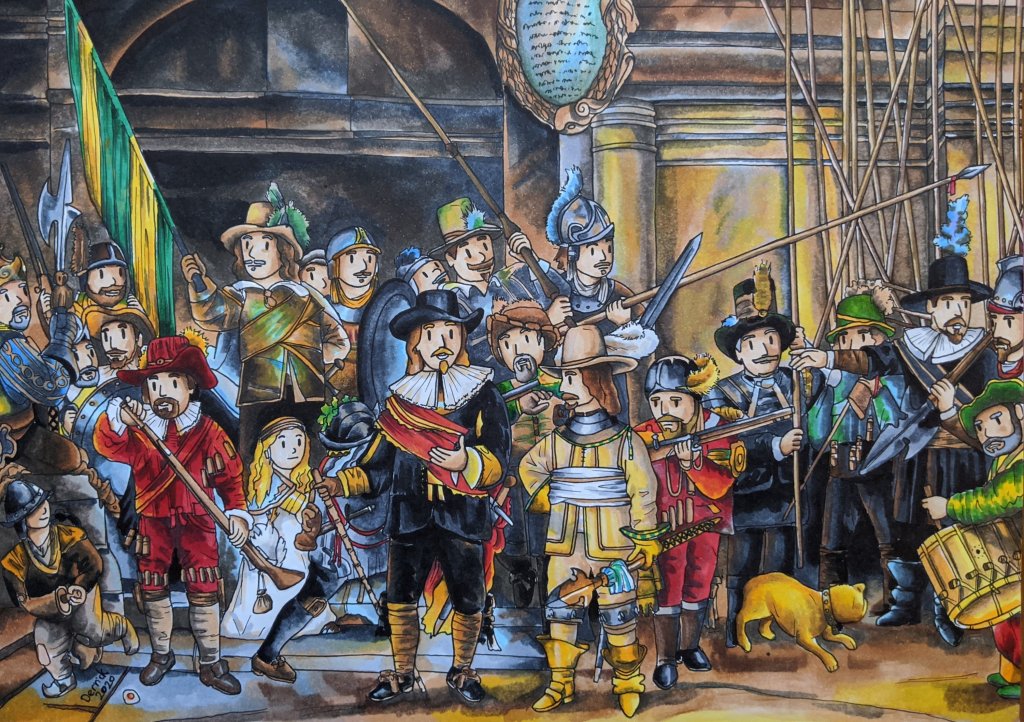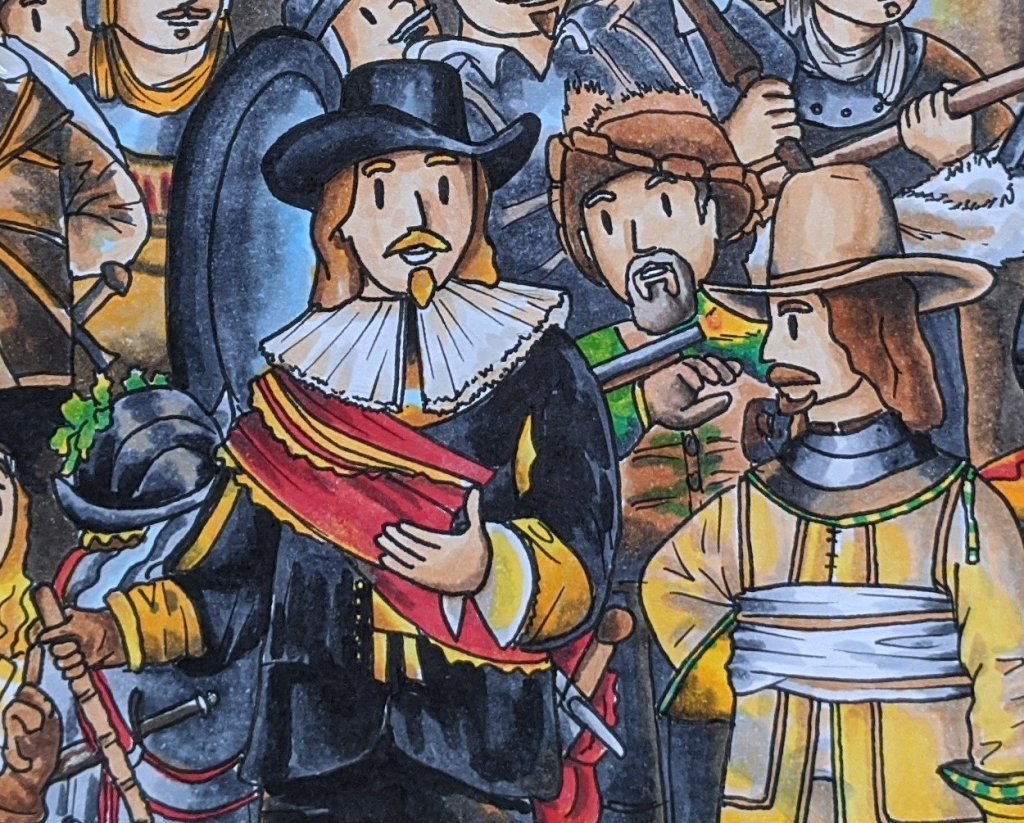I’ve used coloured pencils for years now, and I love using them for their versatility, ease of blending and burnishing, and ability to add fine detail. But I was curious to try out a new medium that looked really fun, the wonderful alcohol-based Copic marker. I wanted to throw myself into an ambitious challenge to get to know them better and see what they could do. So, after some practice cartoons, I decided to reproduce Rembrandt Van Rijn’s epic masterpiece The Night Watch (1642).

I was looking for a beautiful artwork that would allow me to practice lots of poses, colour lots of faces, and The Night Watch fit the bill perfectly. It’s also a fascinating piece, with lots of hidden tidbits to discover, and recreating it would be the best way to get to know the artwork.

Planning and Composition
Rembrandt’s The Night Watch is a masterpiece, and I couldn’t hope to compete with his mastery of dark and light, his facial expressions or delicacy of poses and compositions. Instead I decided to recreate The Night Watch using my preferred cute cartoon style. It’s a famously dark artwork (it’s called The Night Watch, after all!), so with this new medium of alcohol markers, I aimed to explore the shadows, and bring out the light parts of the picture in vivid colour.

I needed to cut a piece off from the top of Rembrandt’s work to allow for the A4 size I was using, so my piece is longer horizontally, and has less headroom for the characters.
- A4 paper – Aspect ratio of 1:414 (21cm × 29.7cm, 8.27in × 11.69in)
- The Night Watch – Aspect ratio of 1.2 (363cm × 437cm, 143in × 172in)
Using Express-it A4 Blending Card for Copics
For the paper, I used Express-it A4 blending card, specially suited to accomodate the blending properties of the alcohol-based ink of Copics. The paper stays perfectly flat even when saturated with layer after layer of juicy alcohol based ink (no warping or curling, yay!).

I used a pencil sketch to lay out the basic design of the piece, and went over the lines with a 0.3mm Staedtler fineliner. The pencil was easily erased from the page afterwards.
Before we dive into the finished piece, let’s take a closer look at this amazing piece of art, and see what hidden tidbits I discovered when I recreated it with Copics.
Who were the members of The Night Watch, and what hidden items are there to find?
Discovering little details in The Night Watch was lots of fun. I got to know all the little faces, and I loved studying what each person was doing. I was able to look in super close detail about weapons and fancy hats, and picked up some cool hidden secrets not immediately obvious to the observer.
The main guy – Frans Banninck Cocq
The central figure with the black outfit and red sash is Frans Banninck Cocq, who was burgemeester (mayor) of Amsterdam from 1651. Cocq also appears in another painting, Bartholomeus van der Helst’s The Governors of the Longbow Civic Guards. A nice detail which I especially love is that Cocq has removed his glove from his gesturing hand, and that glove dangles by a fingertip in his other hand.

The second in charge – Willem van Ruytenburch
His companion, dressed in yellow and with the tall beige hat, is Willem van Ruytenburch, a merchant of the city and a lieutenant in Cocq’s militia. Van Ruytenburch held the noble title of lord (but his family was new to the world of fancy titles, as the lordship was purchased by his father). And we can see his wealth from the way he is dressed, because van Ruytenburch has the fanciest flaired boots in the whole scene!
The girl with the chicken
The third notable member of the party is the young woman, weaving between the militiamen. It is thought she is not a real person, but a symbolic representation of the group. There is a chicken attached to her belt with two meanings; the first being a mascot of sorts to this company of arquebusiers, and the second being a play on words on the commander’s name, Cocq.

The gun being fired
One of the characters is firing his musket into the background. If you look at the left side of the hat of van Ruytenburch in the beige outfit, a plume of fire and smoke is seen. Behind, the man with the floppy brown hat, recoils in shock (see the picture of Cocq, above).
The shooter is the armoured musketeer with oak leaves on is helmet, to the left of his red-sashed Frans Bannick Cocq, with his face turned away and identity secret. And just as well; because he’ll probably get in trouble for the misfire so close to his commander’s head!
In fact, there’s a kind of logical lifecycle of the arquebus in this painting. On the left, the militiaman in red loads his weapon using a small powder canister (which hang from many of the figures’ belts). Then in the centre we have the firing of the weapon, and finally, on the right, a helmeted militiaman cleans his weapon.
The shadow of the hand
An amazing little detail of this painting is the exquisitely painted shadow of Cocq’s gesturing hand, falling across the yellow coat of van Ruytenburch. It’s not easy to spot at all, unless someone points it out to you. Closer inspection reveals that this shadow hand actually cups a roaring lion embroidered in van Ruytenburch’s coat, part of the coat of arms of Amsterdam and signifying that the city is in safe hands.
This extraordinary detail wasn’t possible to include in my miniaturised version, but it’s worth searching for on Google!
The plaque
A large plaque hangs above the company, on the edge of the archway. On it are the names of all the members depicted in the painting. This was actually not part of Rembrandt’s original piece, and was added on top decades later by a different painter.
Rembrandt’s cameo in The Night Watch
The little face peering out inbetween the standard bearer and the helmeted militiaman is thought to be none other than Rembrandt himself, in a cheeky cameo!

The history of The Night Watch
Rembrandt’s masterpiece did not have a dull history. It was cut and chopped, vandalised and painted over, survived an acid attack, and was even rolled up to hide from the Nazis. The epic canvas is 3.63 metres x 4.37 metres, and weighs a whopping 337kg. Besides its original sale, it’s never been sold since, and it is considered priceless.
The original title was not The Night Watch. In 1642, when Rembrandt finished the painting, it had no title, but was soon being called Civic Guardsmen of District II under the Command of Captain Frans Banninck Cocq. By 1797, the varnish which covered the painting had significantly darkened, leading people to start calling it The Night Watch. The nickname stuck, but the Rijksmuseum still calls it by its first name.
In 1715, the painting was relocated from its original home in the Great Hall of Amsterdam (Kloveniersdoelen), where the arquebusiers would meet, to the new location at the Amsterdam Town Hall. It would not fit on the proposed wall, so all four sides of the painting were sliced off to trim it down, completely removing two figures on the left and moving the central figures from off-right to the centre of the picture, changing the original asymmetrical aspect.
The Night Watch moved again during Napoleon’s occupation, when it was moved to the mansion of the arms-dealing Trip family, the Trippenhuis. It remained there until 1885, when it was moved to the newly built Rijksmuseum, built specially for The Night Watch.
In 1911, it suffered its first vandal attack, when an unemployed shoemaker attempted to slash the canvas with a knife, but was unable to damage it. When World War 2 broke out in September 1939, the painting was removed from its stretcher bars and rolled up around a special roller. It was kept in a safe in Maastrict for the duration of the war.
1975 saw the painting slashed again, this time by another unemployed man, who put 12 huge slashes into it that took four years to restore. In 1990, another vandalism attempt occurred with an acid spray attack, but only the varnish was affected. Finally, 2019 was the beginning of a large restoration effort, Operation Nightwatch, to further study and restore the masterpiece.
Using Copic Markers
I completed my Copic sketch of the Night Watch using 16 marker colours, and it took about one week. I used a lot of browns, warm greys and cool greys that made up most of the picture, as well as (gasp!) the forbidden shade black to fill in some of the shadow areas.

I used highlights of yellow, red and a small amount of blue in many of the outfits, and to create reflections off the metal areas. For faces, I only had four skin tone markers, so the ability of introduce some skin tone variation was much reduced.
In the end, the colour palette was far too small for a picture of this scale, and I could have easily used both lighter and darker variants of those colours to help give some gradient and depth. But hey, I’m just a beginner!
Some of the most fun was actually shading in the darker areas of the background, where I had more available space to blend and gradient the colours. Over-blending in tight areas such as clothing folds risked bleeding the ink outside of the lines. Using the Xpress-it paper was wonderful, and I could really put down a lot of ink to make a very ‘juicy’ mix of colours.
One really cool effect that I noticed was the bleed-through of the ink onto the other side of the page. Anticipating this, I used a backing paper to prevent my other Xpress-it blending card pages from being ruined. The result of all that bleed-through is a really satisfying blotted and mirrored copy of the piece, which feels like a photo negative where the white lines replace the black fineliner.
Conclusion
The end result of my Copic marker Rembrandt challenge looks wonderful, and a complete success! I have some elements I would change for future pieces, most notably choosing a larger range of colours (particularly skin tones), as well as choosing a piece with more flat open spaces to try and maximise the blending potential of Copics.
I’m looking forward to going back and trying to recreate another masterpiece in my style!
What do you think about the result? What artwork would you like me to try and recreate using Copics?